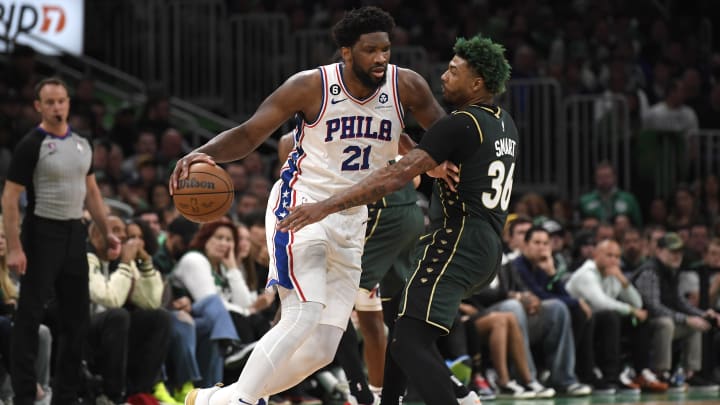Only the Celtics’ Defense Can Salvage Their Playoff Hopes

This is why you can’t take a single playoff game for granted.
After a thorough defeat at the hands of the Sixers in Game 5, the Celtics now trail in their second-round series 3–2, a series that started with Joel Embiid injured and Boston unable to capitalize at home in his absence.
There were a few reasons the Celtics lost Tuesday—a lack of outside shooting and Embiid’s greatness among them—but their defense was perhaps the most troubling. For a team that finished second in the league in defense in the regular season, Boston needs to be much better on that end of the floor if it wants to keep its playoff run alive.
In their first 82 games, the Celtics posted a 110.6 defensive efficiency. Since the start of the playoffs, that number has dipped to 114.2. That’s the difference between the No. 2 defense in the league and the No. 20 defense. Yes, the playoffs are supposed to be more difficult, but this is largely the same Boston team that posted a 106.2 defensive rating last season—and followed it up with a 106.3 defensive rating in the playoffs. In their Game 5 loss, the Celtics allowed 121.1 points per 100 possessions, including a ghastly 129.3 per 100 with Embiid on the floor.
Philly absolutely feasted on basically every Boston lineup. The Celtics are in a tricky position, because if they play two-big lineups Embiid can float off of a nonshooter on defense. But their one-big lineups haven’t been effective consistently. Boston is playing a lot of drop on the James Harden–Embiid pick-and-roll, which has freed both players to get to their spots over and over again. And outside of Game 3, when Al Horford shot 5-of-7, he hasn’t hit enough threes to tilt the math back into Boston’s favor on the other end of the floor.

Time and again in Game 5, the Sixers abused Boston’s half-hearted drop. And unlike the Nets, the Celtics haven’t always been as steadfast in sending doubles at Embiid. Philly did a good job having Embiid screen very high for Harden in Game 5, opening up his space to roll. He also operated much more facing up near the block as opposed to from the free throw line, which seemed to induce some slight hesitation from doubling defenders.
If I were the Celtics, at some point in this series I would have considered trying out a little bit more of what the Nets did to the Sixers in Round 1. Brooklyn played smaller for long stretches and aggressively doubled Embiid whenever he caught the ball. Boston has the personnel to do this, and do it arguably better than Brooklyn did. The Celtics could go very small with a Jayson Tatum–Jaylen Brown center-forward combo, or they could give some more time to Grant Williams and switch all actions—including the Harden-Embiid pick-and-roll. Not only are the smaller lineups more switchable, but also the Celtics theoretically have the shooting to make Embiid guard in space on the other end of the floor.
That’s a risky strategy, though. It’s not easy to change your style of play this late in the season, especially when elimination is on the table. While shooting better themselves will certainly make a big difference, the Celtics can’t let Harden and Embiid waltz into their favorite spots on the floor with ease in Game 6.
All playoffs long, we’ve been waiting to see the same Celtics team that was a two-way force during the regular season. Boston was the only team in the top five in offense and defense, and it was second in both. But the Celtics have had baffling lapses throughout this postseason, letting Atlanta hang around for too long and dropping a home game to the Embiid-less Sixers. If they don’t want their malaise to catch up to them, it’s now or never for the Celtics’ defense.
